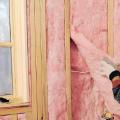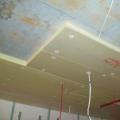How to lay bricks: proper brickwork with your own hands
To a person who is not familiar with the correctness and technology of brick laying, it seems that there is only one option - to lay the brick evenly, that there are simply no other options, that it is impossible to lay the brick otherwise than evenly.
But the most important condition on which all construction work depends is that it is carried out by a professional mason who knows perfectly well how to lay bricks correctly. After all, the bricks have a rectangular shape, so when laying them in rows, any builder, even a beginner, will achieve ideal evenness of the walls. However, this is a big misconception.
The strength of the brick walls of a building being constructed is directly affected by the following conditions:
- The quality of the building material, which consists of bricks and cement mortar.
- Weather conditions under which brick walls are constructed.
Laying brick walls and partitions
It turns out that for proper laying of a brick wall there are several requirements that must be adhered to:
It is necessary to constantly ensure that the solution is applied under the brick in the same amount, otherwise it will be almost impossible to make the edge of the outer row of brickwork even.

Rules for bricklaying walls and partitions.
The brick is placed on the prepared work surface so that it lies parallel to the row. In this case, its outer side coincides with the plane of the brickwork - it turns out to be oriented along three rotary axes.
When laying bricks, follow the basic rules:
- The brick must have the correct linear position.
- The masonry must have the same height of all rows.
- The bricks must fit snugly against each other.
However, even if these requirements are met, without the proper experience and skills in bricklaying, you may not get a correct and even laying the first time. Therefore, it is necessary to familiarize yourself with the theoretical technology of doing this work yourself. Knowledge of technology will help you correctly cope with the practical part of the work.
Tools needed for bricklaying
To properly organize the work process for laying bricks, you must have high-quality building material (brick and cement mortar), as well as stock up on special tools and equipment:
- Mortar or mixture for laying bricks, prepared in compliance with the required proportions and in accordance with all the rules.
- Bricks in sufficient quantity (building material).
- A construction wheelbarrow, which is necessary to deliver bricks from the place where they are stored to the place where the brick wall is being laid.
- A trowel or trowel, which is used to lay out the solution on the work surface and to remove excess mixture.
- Construction glasses used to protect the eyes from dust or hard mechanical particles getting into them.
- A carpenter's square, which is used to connect corner parts of brickwork.
- A building level that helps to lay out evenly not only the first row of brickwork, but also the next ones.
- A pick-hammer used to split bricks.
- Using a tape measure, it is used to take linear measurements when laying bricks.
- Chalked cord to help determine the brick laying line.
- A mason's cord that can be used to create straight horizontal lines in courses of brickwork.
Cement mortar for bricklaying
Preparing mortar for laying brick walls is not difficult. The solution contains cement and sand in an optimal ratio of 1:5 (take one part cement to five parts sand). To make the solution plastic, you can add a little clay or lime to it as a component.
The first step in preparing masonry mortar is mixing cement and sand. This is done without adding water - the components must be dry. Then the finished mixture is taken in small quantities and combined with water with thorough mixing.

Features of preparing cement mortar for brickwork.
Mixing in small batches helps prevent premature hardening of excess amounts of the prepared mixture, thereby saving money on additional purchases of cement.
To save mortar, do not use “hollow” bricks, since most of the mortar goes into the holes, as a result of which there is not enough prepared masonry mixture to strengthen the brick.
Today, when building houses and cottages, not every site owner turns to professional builders for help. Some are financially limited, while others adhere to the life rule that states that a real man should build a house, plant a tree and raise a son.
It is these site owners who should familiarize themselves with the theory of bricklaying before starting practical work.
Brickwork technology
If you purchased a plot of land on which you decided to build a brick house with your own hands, you should know about the correct execution of brick wall laying work. If you do not comply with the necessary requirements, you may build an unreliable structure.
The first rule when carrying out work on laying brick walls is the following: you can start laying bricks only after the pre-made foundation has completely hardened, otherwise the walls will lead in different directions and your work will be in vain.
So, when laying bricks, it is necessary to perform work according to the following technology:
Before laying the first row of bricks, you need to lay roofing felt on the completely dry foundation, folding it in two layers. Before this, you need to decide how you will build the walls: one, two or one and a half bricks.
It goes without saying that if you lay the first row of bricks unevenly, it will be impossible to achieve evenness when laying out subsequent rows. Therefore, you must use special construction tools that can be used to lay brickwork correctly and evenly.
The next requirement that must be observed when laying brick walls is that it is imperative to leave gaps between the bricks. The minimum gap should be 3 cm. The gap is made to ensure that the mortar can be evenly distributed between the bricks when laying the wall.

Checking the quality of brickwork using a level.
Do not forget to periodically check the correctness of the masonry directions in the horizontal and vertical planes using a building level.
The correct layout of the corners of a structure is 50% of the successful completion of all work. Before laying bricks, several rows of corners are laid out. An important condition for carrying out the work is the use of horizontal and vertical building levels, since it is the correct layout of the corners that is the key to correctly laid out walls of the house. Therefore, when carrying out brick laying work, it is necessary that the corners of the house structure constantly rise above the main walls by a couple of rows.
When planning to plaster constructed brick walls, be sure to use the “empty-fill” method, which consists of distributing a certain volume of mortar between the bricks in such a way that it fills the gaps between them.
When laying out a chimney chimney, you need to completely fill the empty space between the bricks with masonry mortar so that soot does not settle on the inner walls of the chimney. When performing facing installation, it is also necessary to completely fill the seams with masonry mortar.

Correct placement of corners when laying brick walls.
To create even and right angles in a house structure, it is necessary to have a “order”, which are metal corners that allow you to determine the correct placement of bricks. The “ordering” is fixed at the corners using special brackets to ensure the correctness of the design.
To ensure even laying of bricks in rows, it is necessary to have special construction tools - a building level, a mason's cord, a tape measure, a chalk cord, which are recommended to be used constantly during brick laying work.
Professional masons offer the following advice:
When laying brick walls, be sure to watch the seams - they should not match in subsequent rows, otherwise the wall will become unstable and easily fall apart if force is applied to it.
Be especially careful in your approach to construction - before laying a brick wall, first draw up a work plan in which you indicate how many bricks you need, as well as how many rows of bricks need to be laid.
Laying facing bricks.
If you lack the skill, when laying facing bricks, you can use traditional methods of laying ordinary building bricks, and get normal results. Facing bricks have almost no differences from ordinary ones. They have a more aesthetic appearance and a different purpose.
When performing calculations to determine the required amount of bricks, be sure to add 10% of the total quantity to the resulting figure in order to have a supply of bricks, since approximately the same number of bricks can split during laying of a brick wall.
To ensure the greatest adhesion between the mortar and the bricks, before laying the bricks, you need to wet them by lowering them into a container of water.
In order to learn how to lay brick walls correctly, you need to be patient and take your time. Due to the fact that the masonry mortar does not dry out immediately, if the need arises, defects can be corrected.
 Construction materials and list of works
Construction materials and list of works Proper insulation of a wooden ceiling in a private house
Proper insulation of a wooden ceiling in a private house What types of crushed stone are there?
What types of crushed stone are there?